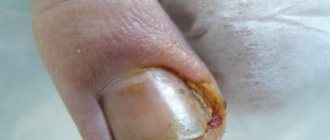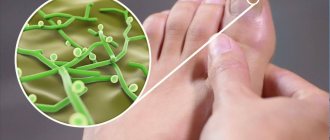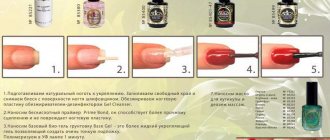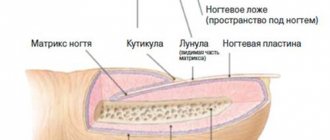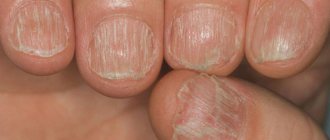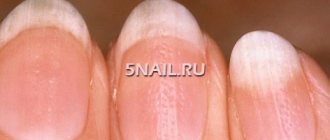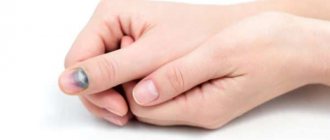According to statistics, nail problems affect most of the population of our planet. Some people suffer from ingrown toenails, some from deformed nail plates, others from a fungal infection. In all cases, patients are concerned about an obvious cosmetic defect, which does not allow them to wear open shoes and live normally, and with fungus, itching generally appears. Sooner or later, the patient still wonders what a nail doctor is called, who to contact and how to get rid of his problem. This question is very important, because the sooner the patient turns to the right doctor, the sooner he will get rid of his problem. You shouldn’t delay, you need to immediately figure out what’s really bothering you and who you need to go to.
Who to go to
The choice of a specialist depends primarily on the problem that worries the patient. So, if you have an ingrown toenail, you should immediately visit a surgeon, he will remove part of the nail and install a special orthopedic plate so that the nail plate grows correctly and does not deform further. For other problems with nails, for example, deformation or changes in the color and thickness of the nail plate, the doctor should be called a dermatologist and mycologist. He usually prescribes tests and treatment. A specialist who treats nail and skin fungus is called a mycologist. A doctor who will help get rid of ingrown toenails in the initial stages, prevent diabetic feet, and provide quality nail care is called a podiatrist. This specialist is something between a surgeon and a dermatologist, he specializes in foot hygiene and treats them with conservative and orthopedic methods. It is worth noting that dermatologists treat nail fungus, just like mycologists, but in some severe cases it is impossible to do without a competent specialist in this field. It is usually difficult to find mycologists in public clinics, so you can safely contact a dermatologist with any nail problem, and if necessary, he will refer you to other specialists.
What cures
Dermatologists, podologists and mycologists are involved in the diagnosis and treatment of pathologies of the skin, hair and nail plates:
- Mycoses (fungal infections of nails and skin);
- Deformation of nails, their fragility or thickening, etc.;
- Ingrown toenail in the initial stages;
- Dermatitis and rashes of various types, including allergic ones;
- Viral skin diseases;
- Problems with sebaceous and sweat glands.
For any problems with nails, you should immediately go to a dermatologist, but it is worth noting that if the presence of an ingrown nail is obvious, then it is better to contact a surgeon immediately so as not to delay treatment. In the early stages, when the skin around the nail is not inflamed, a dermatologist may recommend conservative treatment. But, if the nail plate has grown too much and the problem is accompanied by pain, swelling and suppuration, you should immediately go to the surgeon.
Choosing a specialist
It is impossible to give a definite answer to the question of what a nail doctor is called, since depending on the specifics of the disease, you have to contact different specialists.
When answering the question, what is the name of the doctor who deals with nails, it is worth listing the following specialists:
- surgeon;
- mycologist;
- dermatologist;
- podologist
Now let’s consider which doctor to contact with this or that problem of the stratum corneum. So, if you have ingrown toenails, then you should consult a surgeon. This specialist will surgically remove part of the horny formation and install a special orthopedic plate that will allow the horny formation to grow in the correct direction and no longer grow into the soft tissue.
If a patient has toenail fungus, the doctor who treats the disease is called a mycologist. However, a dermatologist can also cure this disease. The fact that the nail is infected with a fungal infection can be guessed by its thickening, deformation of the nail plate and discoloration. The doctor usually conducts special tests that allow you to clarify the type of infection and select the right therapy.
Important! The name of a doctor who treats fungal infections of the skin and nail plates is mycologist.
Another doctor who treats nails is called a podologist. Contact this doctor for advice regarding diabetic foot, he will also help at the initial stage of the formation of an ingrown toenail. You can consult a podiatrist regarding proper care of your nail plates. We can say that a podiatrist is something between a dermatologist and a surgeon, since his specialization is foot hygiene. Various diseases of the horny formations can be cured with orthopedic and conservative methods.
Why do nails come off the skin on my hands?
If we talk about which doctor treats nail fungus, then we can say that this problem is within the scope of activity of a dermatologist and mycologist. However, a narrower specialization of a mycologist will help to deal with complex cases of fungal infection of horny formations. As a rule, you will not find a mycologist in our public clinics, so if you have fungus on your fingernails or toenails, you can safely go to a dermatologist, and he, in turn, can refer you to another specialized specialist if necessary.
It's time to see a doctor
It is clear which doctor treats nails on the feet and hands, but in what cases you should definitely go to the doctor, and when you can treat yourself - this question worries many. Indeed, nowadays it is very difficult to find a few hours to visit the clinic, but it is still worth doing it if you have the following symptoms:
- Redness of the skin around the nail plate, pain when pressing it;
- Suppuration under or near the nail;
- Severe deformation of the nail plate;
- Thickening and thinning of the nail plate;
- Itching around the nail, between the toes and on the skin of the feet;
- Persistent ingrowth on the big toe.
The symptoms above are signs of serious pathologies, most often in advanced form, which can lead to infection and suppuration with subsequent complications. Itching and deformation at the same time are usually accompanied by a fungus. A fungal infection is very contagious, and the longer it is left untreated, the more difficult the treatment will be in the future. It is also worth noting that fungi can also affect internal organs, which can be very dangerous to health. In all the cases described above, you should consult a doctor as soon as possible and not delay treatment. Of course, even in the initial stages, it is best to be treated under the supervision of an experienced specialist; this will help to quickly and permanently get rid of the problem. If you have to postpone your appointment with the doctor for a while, and the problem has already been discovered, then you need to take some measures at home yourself. Of course, home treatment without examination is unlikely to be effective, you should not rely on it, but it will help stop the disease for a while. First of all, you need to take care of your feet, wear good shoes and cotton socks. Take care of your nails every evening, take medicinal baths, and regularly do pedicures without using nail polish or extensions. You also need to adjust your diet, make it healthy and balanced, and also give up smoking and alcohol.
How does an appointment with a specialist work?
At the first appointment, the doctor who treats nails visually assesses the situation and collects a detailed medical history of the patient:
- Lifestyle,
- eating habits,
- conditions of professional activity,
- duration of the disease,
- features of the pathology.
Next, the nail and skin around it are scraped. A preliminary diagnosis is made using a microscope. To confirm it, the biological material is sent for cultural analysis (seeding), which will allow the type of fungal infection to be determined.
Laboratory testing takes several days or even weeks.
How it treats
A visit to mycologists and dermatologists usually begins with a visual examination and questioning of the patient. The specialist will ask what exactly is bothering the patient and for how long, what it might be connected with in his opinion. You also need to remember whether your relatives have ever had similar problems and you will have to talk about your lifestyle, places of work and recreation. It is best to immediately prepare and try to give yourself answers to all the questions described above; truthful answers will help the doctor quickly establish a diagnosis and recommend treatment. To determine the presence of infection, the doctor makes a scraping and takes several scales for analysis - this procedure is painless. If, in the doctor’s opinion, problems with the plates are associated with other pathologies, for example, with thyroid disorders, then the patient will definitely be sent to an endocrinologist. You may also need to consult a therapist, surgeon and other specialized specialists as necessary. For pathologies of the nail plate, dermatologists prescribe the following treatment:
- Local agents to soften or strengthen the nail plate, or antifungal ointments, nail polishes, if necessary;
- Antifungal drugs orally if necessary;
- Vitamin complexes to strengthen nails and immunity;
- Balanced diet;
- Therapeutic baths for hands and feet;
- Hardware manicure and pedicure.
As a rule, nail pathologies require long-term treatment, at least until the nail plate is completely renewed. But even when a healthy nail grows, the patient must continue to properly care for his hands and feet in order to prevent relapses of the disease.
Carrying out treatment
Getting rid of nail plate fungus can take quite a long period. At this time, you need to regularly visit the mycologist and strictly follow all his instructions. Only in this case will it be possible to speed up recovery and get rid of frequent visits to doctors.
Taking tests
Over the entire period of treatment, the patient will have to undergo more than a dozen tests. They are taken not only to determine the type of fungus, but also to control each stage of treatment. Such an integrated approach will help make the correct diagnosis and determine the sequence of treatment. The mycologist may refer the patient for the following tests:
- Scraping of skin flakes. This painful procedure is performed in a special laboratory located in the skin and venereal disease clinic. For analysis, skin is taken from the foot and the area between the toes.
- A piece of a sore nail. A small part is cut off from the infected area and sent for examination.
- Blood sampling for antibodies to the fungus.
- Donating blood for allergic antibodies.
If the test results did not reveal any traces of a fungal infection, then the mycologist prescribes histology to the patient. Thanks to this special analysis, the absence of onychomycosis is confirmed or refuted.
Therapy methods
After carrying out all the necessary tests, the mycologist determines the method of treatment and prescribes the necessary medications. It is forbidden to select them yourself, as you can harm your health and worsen your condition. At each stage there is its own method of getting rid of the fungus:
- Perioral. If the specialist has decided on this method of treatment, the patient will be prescribed various tablets. They must have a comprehensive effect on the fungus and treat it from the inside.
- Local. This method, like the perioral method, is used only in the initial stages of the disease. It involves the use of medications that are used externally. These include various antifungal ointments, creams, drops, varnishes, and compresses. The drug is applied to the infected area in the required quantity and at the frequency determined by the attending physician.
- Laser. This is a more expensive but effective method of treatment. It is used for advanced disease and is carried out according to the doctor’s instructions. A special laser affects the problem area and improves the penetration of medications into its focus. In addition, it promotes better microcirculation of tissues, which significantly accelerates their recovery.
- Surgical. This method is used only in the most extreme cases, when it is impossible to save the infected nail. The mycologist refers the patient to a surgeon, who conducts an examination and sets a date for microsurgery.
Treating toenail fungus is a rather difficult undertaking that requires a lot of time and money. If you choose the right doctor and follow all his instructions, you can quickly get rid of the disease.
Sources:
https://idermatolog.ru/problemy-s-nogtyami/kak-nazyvaetsya-vrach-po-lecheniyu-nogtej-i-kuda-obrashhatsya.html https://gribokbolezn.ru/gribok/na-nogtyah/kakie-vrachi -lechat-gribok-nogtej.html https://gribokguru.ru/lechenie/kakoj-vrach-lechit
Useful tips
We answered which doctor treats nail plates, but how can you avoid problems with nail plates so that you never contact such a specialist? Dermatologists are definitely very useful doctors, but each of us would not want to meet with them again. There are preventive measures that dermatologists and mycologists always tell their patients about so that they do not get sick again. By following them, you can significantly reduce the risk of nail plate pathologies and save yourself from long-term treatment:
- First of all, you need to eat well. A balanced diet ensures a strong immune system, which reduces the risk of nail fungus; in addition, the nail plates themselves look beautiful and healthy with enough nutrients.
- You need to maintain hygiene, wash your clothes every day and take care of your feet;
- You need to wear good shoes that do not squeeze your toes and take proper care of them;
- Contact with chemicals should be avoided;
- You should not walk barefoot in crowded places;
- It is not recommended to use harmful nail polishes and constantly extend your nails.
Share:
Paronychia - purulent inflammation around the nail
Paronychia is an inflammation of the periungual fold, that is, the skin and soft tissue that frames and supports the nail, one of the types of panaritium.
The cause of paronychia is infection, and the predisposing factor is trauma. The disease is approximately three times more common in women. Sometimes paronychia is caused by a chronic skin condition such as eczema or psoriasis, or another disease such as diabetes or HIV. Paronychia can be acute, where symptoms appear within a few hours, or chronic, lasting longer than six weeks.
Acute paronychia
Acute paronychia usually develops as a result of minor damage to the periungual fold, for example, during a manicure or in those who like to bite their nails. The affected area becomes red, hot and painful to the touch, and swollen. After some time, pus may appear and accumulate around the nail.
The most common cause of acute paronychia is the bacterium Staphylococcus aureus, although any other microbes can also cause inflammation. In rare cases, the cause of a periungual infection is the herpes virus, then they speak of herpetic whitlow. The earliest stages of bacterial paronychia are treated with antibiotics, and often resort to surgical opening of the abscess. Without proper treatment, the process can become chronic.
Chronic paronychia
Chronic paronychia may develop more slowly and may be more difficult to get rid of. It is most common among people whose hands frequently come into contact with water or chemicals, such as cleaners, bartenders, kitchen workers or fishmongers. The disease can begin on one nail, but then affect several. The affected periungual folds become swollen and can sometimes become red and painful, often after contact with water. The nail plate gradually thickens and grooves appear on it, and the nail may turn yellow or green and become brittle.
The skin with chronic paronychia is often abundantly populated with fungi and bacteria, the reproduction of which is normally restrained by the immune system, and against the background of the disease they feel great. In order to cure chronic paronychia, complex treatment is necessary, which may take several months. If cured, it may take up to a year for a healthy nail to grow back. Sometimes you can relieve symptoms by keeping your hands dry and warm, regularly applying moisturizer, and not biting your nails.
If the disease is severe, you should consult a doctor. Depending on the type of paronychia, creams and (or) tablets may be prescribed, which should be taken according to the instructions. The doctor may prescribe additional examination.
How to choose a doctor to see?
In order not to waste time in queues to see various doctors, trying to determine the cause of the disease, you need to pay attention to external symptoms. It depends on them which specialist should be contacted first.
For fungus
Onychomycosis (fungal infection of the nail) is easily determined by external signs.
- At the first stage of the disease, small dots and white stripes appear on the nail plate.
- With the second, the symptoms become more obvious. The natural shine disappears, yellow and brown stripes appear, and the nail begins to deform.
- In the third, advanced stage, the nail plate and cuticle are destroyed, and the disease spreads to the skin of the foot.
With an ingrown nail plate
If you have an ingrown toenail without signs of fungal infections, you will need to seek help from a podiatrist or surgeon. If there are even slight signs of concomitant infectious diseases, you will first need to be examined by a dermatologist.
With onychogryphosis
This disease is better known as bird's claw. It most often appears due to severe bruising of the fingers or frostbite. If this problem occurs, you will need to seek help from a surgeon.
Symptoms of toenail fungus
Onychomycosis is an infectious disease and develops as a result of the proliferation of fungal microorganisms
The symptoms of the disease directly depend on the group of the pathogen. But, despite the obvious differences, several common symptoms can be identified, which include:
- Change in color of the nail plate;
- Delamination and fragility of the nail plate;
- Painful sensations when pressing on the nail, which worsen as the disease progresses;
- Itching of the tissue around the affected nail.
Should I see a general practitioner or pediatrician first?
Onychomycosis is a sensitive topic. Not everyone at the initial signs of the disease attaches importance to them, therefore, in most cases, the decision to go to the doctor is made late. Nail fungus cannot be cured on its own even with the help of advertised expensive remedies. Therefore, sooner or later you will have to go to the clinic.
First of all, you need to visit a therapist or pediatrician if we are talking about a child. The doctor will analyze the patient’s medical history and give a referral to the right specialist.
If the medical history is not burdened with serious pathologies, the patient is recommended to consult a dermatologist.
In the case of an advanced form of mycosis and the presence of associated complications, contact a mycologist.
If the fungus turns out to be a consequence of diabetes, the help of an endocrinologist is needed.
Sometimes there is another option for solving the problem - with the initial symptoms of infection, the therapist or pediatrician himself can take care of the treatment.
Doctor's actions for onychomycosis
After the diagnostic stage, the doctor determines the treatment regimen. Nail treatment is complex. Systemic drugs (tablets) and local application (ointments, varnishes, drops) are used.
If the disease is recurrent, the patient must be provided with detailed information about previous treatment methods. This will help eliminate the possibility of the pathogen becoming addicted to antimycotic drugs.
In addition to medications, hardware procedures may be prescribed:
- Medical manicure or pedicure - removal of the affected layers of the nail plate with special equipment. This manipulation ensures easy penetration of medications to the lesion.
- Laser therapy quickly and painlessly removes the symptoms of onychomycosis and kills fungal infection.
If treatments are unsuccessful, the nail may need to be completely removed. The operation is performed by a surgeon under local anesthesia. After the procedure, antibiotic ointment is applied to the wound and a bandage is applied. Healing lasts about 2 weeks. At the same time, a course of antifungal drugs is prescribed orally.
A healthy nail grows in a few months.
During therapy, repeated clinical studies may be required to evaluate intermediate results and correct drug effects. The doctor accompanies the patient throughout the entire therapy (3-12 months) until complete recovery.

